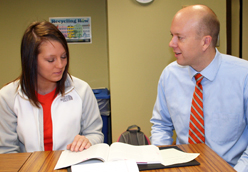
Lander University is one of 11 state colleges and universities in South Carolina participating in the state's Teaching Fellows program, which has won the first Dick and Tunky Riley WhatWorksSC Award for highly effective initiatives in the state.
Jenna Hallman, director of the Center for Educator Recruitment, Retention and Advancement (CERRA), which oversees the program, said the award belongs to all Teaching Fellow institutions, their campus directors, current Fellows and graduates.
The General Assembly established the program in 1999 to recruit and retain well-qualified teachers for South Carolina classrooms. A video produced by SCETV and focusing on Lander's Teaching Fellows program was a key part of CERRA's entry in the WhatWorksSC award competition.
A nonprofit organization, CERRA is the oldest and most established teacher recruitment program in the country, having been created by the Commission on Higher Education in 1985.
Dr. Lee Vartanian, assistant professor of teacher education, is the director of Lander's Teaching Fellows program. He said 33 students are enrolled as Teaching Fellows and each receives an annual scholarship of up to $6,000 from the state. In return, Fellows make a commitment to teach one year in South Carolina for every year they received scholarship assistance.
To be considered, students must be high school seniors with records of outstanding academic achievements, a history of leadership and service to their schools and communities and a desire to teach in South Carolina.
After a screening committee validates their qualifications, applicants are invited to a regional interview that includes a writing assignment. The top 175 students who complete that process are accepted into the program.
Vartanian explained that Fellows complete the same teacher education courses as their classmates, but with additional requirements for 30 hours of service learning each semester. They help with classroom and other activities at local schools and serve on committees dealing with education reform and advocacy and school and student partnerships. They are also responsible for organizing three assemblies for Teaching Fellows each semester.
Alison Haynes, of Ninety Six, a sophomore elementary education major, is in the program. She was encouraged to apply by a teacher during her senior year at Ninety Six High School. She is following in the footsteps of her sister, Jessica Williams, a 2009 Lander alumna and Teaching Fellows graduate. As part of her service learning, Haynes assists her sister with activities at Mud Pies Creative Learning Preschool in Greenwood, where she is a teacher.
Haynes said the program is great, and the scholarship assistance she receives is a tremendous benefit.
Vartanian said the Teaching Fellows program is unlike a regular classroom setting. "When I teach other classes, I'm in charge and control the narrative." As director, he offers guidance and remains a presence, but he allows Fellows to take the initiative and ownership of the program. "I'm a facilitator rather than a 'sage on stage'," he added.
He said the program's mission is to develop qualities that will make the students better teachers and better leaders. He describes the program as an investment in quality education, adding that it has had "incredible success" retaining teachers.
CERRA reports that, between 2000 and 2006, it graduated more than 900 Teaching Fellows, a 75 percent completion rate. Another 71 fellows are employed in 75 school districts in the state, more than half at what are called geographic critical needs schools in low income areas.
Of the 261 graduates who have satisfied teaching requirements equal to the number of years they received scholarships, 85 percent of them are still teaching in South Carolina.